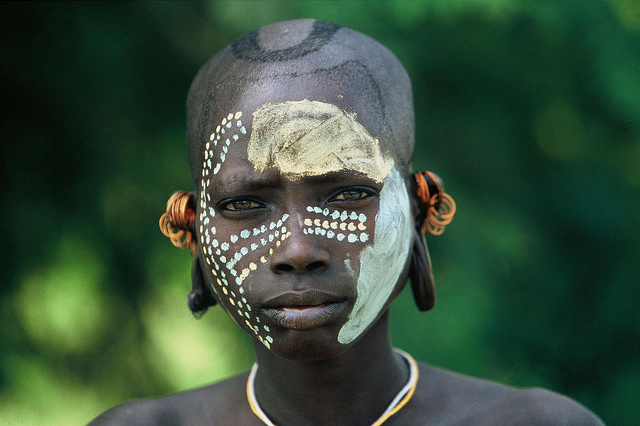FAQ: Emergence of Human
03 Nov 2016
7 facts about the great apes and human evolution
Man, like any biological entity, it passed a long way of evolution. In principle, this way you can begin to count down from the pre-Cambrian era, literally starting from bacteria, an RNA world. Typically, the evolutionary path of the person start to count or with the appearance of primates or with onset of bipedalism.

1.Weight symptoms that many people seem to be purely human, the person referred to is actually in far-distant past. For example, hiccups, yawning - a legacy of almost fish. Accordingly, if the approach to the present, the main stages of primate evolution lies in the fact that 65 million years ago there was a detachment of primates (like most other groups of mammals), subsequently had several radiation levels (increasing diversity), and the order of 25-26 million years ago there were apes. They are quite different from today. This is very important because often people believe that there is an abstract man and monkey. In fact, a monkey is extremely diverse. And these ancient hominids were in many ways similar to modern man more than a modern chimpanzee are similar to these very ancient apes. In other words, a man in his structure has retained a lot of very primitive features.
2.Those apes that emerged first were called proconsuls. They lived happily in the tropical forests of Africa, but around 10-12 million years ago have begun significant climate change: it became noticeably colder and drier and a large tropical rain forest that covered almost all of Africa except the north and of the south, began to fade . And monkeys that live in these forests, there were three options for the further fate of either extinction - most species of apes followed him, and from them there were only bones, or those living in forests that have remained in Africa. Tropical rainforests are in Central and West Africa. Now they live gorillas and chimpanzees are two types: common chimpanzee and the bonobo (pygmy chimpanzee). Interestingly, the gorillas and chimpanzees have evolved too. They are the same as the structure of primates that lived 10-15 million years ago, and they have changed in some respects stronger than we are in comparison, say, with the proconsul, who lived 20 million years ago. But apes of tropical rain forests - is a kind of evolution of the peak, as they lived, so they remained there. The third option - the output is in savannas formed on the site of tropical rain forests. Reasons to move to Savannah was quite a lot. But the combination of features so happened that it turned out more profitable to walk on two legs across the savannah, savannah because the body and the head is less overheated, it is better to look over the grass easier to carry young prey. And, accordingly, those apes who came in and became bipedal savanna, called Australopithecus.
3.Australopithecines at bipedal form known since about 7 million years ago. The oldest bipedal primate - it Sahelanthropus, found in North Africa, in the Republic of Chad. Group Australopithecus since from 7 to 4 million years earlier called Australopithecus. They were all signs the same as apes, but only with small teeth, is not particularly prominent, and with more or less vertical position of the body - they were not yet fully walked upright. They might as well could climb trees, still, as their ancestors; can sometimes run on all fours. The most remarkable discovery, made in 1994, and much later, in 15 years, described fully, - a skeleton of Ardipithecus. Practically the whole skeleton, in which the mass of the visible features of these early australopithecines.
At the time of about 4 million years ago, the australopithecines doevolyutsionirovali to stage gracile australopithecines. These were the creatures of the meter to one and a half meters tall. Their structure was a wonderful combination: lower heads were almost already people, though still with monkey features, but the head was still, in fact, the monkey. And most importantly - they had another monkey brain volume. Those 400-500 grams, as well as chimpanzee and gorilla. These creatures are even tools are not produced. However, since they were already fully bipedal - a legacy of pets already have weathered - his hands were free, and they are doing something. What exactly did they do - even science is not yet known, but as modern chimps and make tools and use them, it seems, at the same level were Australopithecus gracilis. They are known to North Africa a little bit and have a lot of discoveries in eastern and southern Africa.
4.About 2.5 million years ago there was a new climate change in the same direction: the climate became drier, colder. Although there was no frost, but it became colder. There were even more open space. And these gracilis Australopithecus gave two main lines: the massive Australopithecus (a dead-end line) and the so-called early Homo, part of which was us. Massive though australopithecines are not our ancestors, but it is interesting because it is such an alternative path of development - specialty food coarse plant food. They had huge heavy jaw, massive chewing muscles, huge teeth. But about a million years ago, they died out safely. Accordingly, the second group - the so-called early Homo. The most common and widely they are known as Homo habilis (handy man), as an option - Homo rudolfensis (Homo Rudolfensis). The difference between these terms is not particularly important. They differ little in structure purely morphologically from the gracile australopithecines, but it's great that they began with the rapid growth of the brain. They began to produce the first tools, and 2.7 million years ago, there are the first stone tools. At the time of 1.8 million years ago, they started very rapid brain growth, and brush has become adapted to the manufacture of stone tools.
5.It begins quite have the main line towards us, as with dating about 1.5 million years there are traces of the use of fire (though not all archaeologists recognize them as valid), and even a little older, 1.75 million years ago, the oldest traces of dwelling in Tanzania. About 1.8 million years ago, people left outside Africa. This was the so-called stage of Homo ergaster (people working). Subsequently, people settled on the tropics - it erestus Homo (Homo erectus), but walking upright occurred over many millions of years before that confuses many name appeared due to the order of discovery of ancient hominids. And they were the bearers of a new culture, the so-called Acheulean industry, more advanced. Some 400 thousand years ago, a new type - Homo heidelbergensis (Heidelberg man). It is distinguished by the fact that already inhabited temperate areas, ie areas with a temperate climate, and its brain size was already about as we do.
The period 130-150 million years ago to 40 million years ago - this time the so-called paleanthropic, of which the most famous - Neanderthals lived in Europe and western Asia. They found a lot, they are better known. But the main line, which leads us, evolved in Africa. And in the time interval from 200 thousand years to 40 thousand years ago in Africa on the basis of the later geydelbergensis and paleanthropic formed a kind of Homo sapiens, which at the time from 80 to 50 thousand years ago - while the exact dating remains unknown - went again beyond Africa and it is almost completely populated the entire planet. And by the time about 40 thousand years ago, we almost everywhere except America and Polynesia, we find already fully modern humans.
6.Currently, the most urgent area of anthropology - a search for the ancestors of modern human relations with some other ancient people, which existed in parallel with our ancestors on the planet. We know that our ancestors originated in Africa, and, say, in Europe at the same time, Neanderthals lived. And in Asia, lived some of his group paleanthropic that no single name is still some reason do not have, but in recent years has spread the term "denisovan", one of the findings in the Altai. And now urgent question: how our ancestors mixed or blended in any percentage they mingled with these Neanderthals, denisovans? In Africa, there is a suspicion that lived some strange hominids, some more ancient people and also gave an impurity to us. And how much influence has been great and it has given us? Ways of our evolution and the evolution of the Neanderthal, Denisovans were markedly different. For example, in some predominantly grown brain, others something else. And the population by exchanging genes, marrying and giving Métis mutually enriched. And, moreover, in the modern population the percentage of impurities varies everywhere. In Africa, there is an admixture of some of their African forms, throughout the world there is an admixture of Neanderthal. In Melanesia, Oceania, Australia has an impurity denisovans. And this is now the most urgent rush Anthropology - proceedings, who is with whom and stirred as it was significant. To improve your brain you can by the help of Actovegin, Peptide Cerluten, Pantogam, Nootropil, Phenotropil, Picamilon GABA, Semax and Cerebrolysin.
7.Currently, the evolution of man is known adequately. In fact, in recent years, with the 90-ies of the XX century and beyond, it has been known for almost anthropogenic detail. Finds the last decades of the XX century and the first decades of the XXI does not complete the picture of something supernovae, and only fill the gaps between the intervals. It is noteworthy that in recent years anthropogeny supplemented with the latest developments, technologies, research, genetics, revealing details of the power of ancient people. And pleased that the mosaic of our knowledge of ancient humanity is becoming more and more complete.

 Cart
Cart





